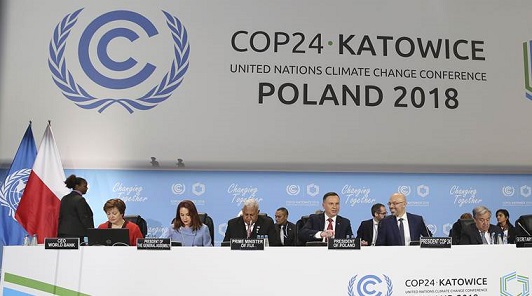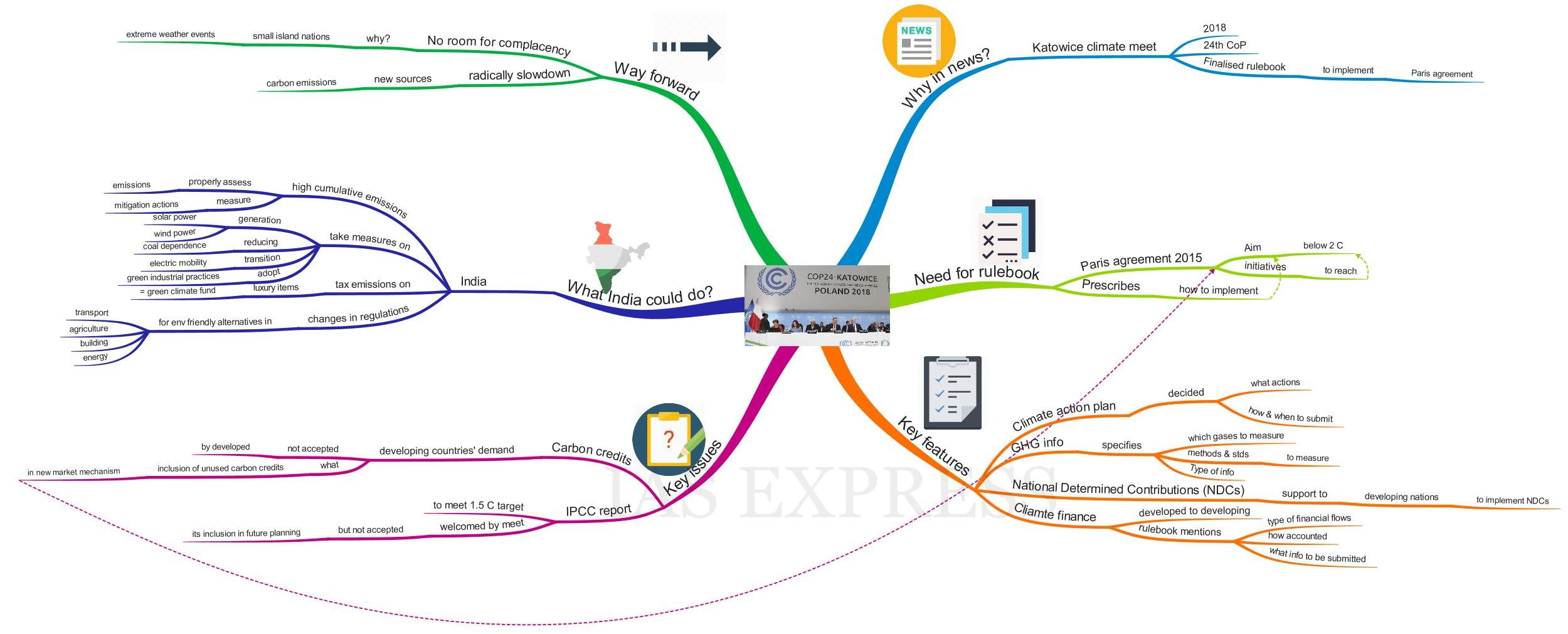Katowice COP 24 Conference – Key Outcomes & Issues

Recently, negotiators from 196 countries finalized a rulebook for the implementation of the 2015 Paris Agreement at the climate change conference held in Katowice, Poland. Katowice meet is the 24th Conference of the Parties to the United Nations Framework Convention on Climate Change (COP24). This highlights the strong support among people of all nations for urgent action to avert dangerous climate change.

What is the need for the rulebook?
- The Paris agreement aims at keeping the global average temperatures at below 20C compared to pre-industrial levels. It provides for the initiatives that countries require to take in the fight against climate change.
- The rulebook prescribes how to implement those initiatives and how each of them would be measured and verified.
What is the Paris Agreement on Climate Change?
- It is an international climate agreement signed in 2015 to fight climate change.
- It enables implementation of global Green House Gas reduction measures in the post-2020, that is, in the post-Kyoto Protocol scenario.
- Under it, all nations must work to keep global temperature rising below 20C by 2100 compared to pre-industrial levels with a major target of keeping the temperature below 1.50C.
- It makes developed nations to provide 100 billion dollars annually to the developing nations starting in 2020 to fight climate change.
- It also empowers nations to determine how to reduce their emissions. However, it mandates that they report transparently on those efforts. This is called Intended National Determined Contributions (INDCs).
What are the key features of the rulebook?
Climate action plan
- The Paris Agreement prescribes that all countries must have an individual climate action plan to be periodically updated and submitted to the UN climate body.
- The rulebook prescribes what actions can be included in the action plan, how and when to submit them.
GHG information
- The Paris Agreement wants every member country to submit information about their greenhouse gas emissions every 2 years.
- The rulebook specifies,
- Which gases to measure.
- What methodologies and standards to apply while measuring them.
- The type of information to be included in their submissions.
National Determined Contributions (NDCs)
- The Paris Agreement mandates nationally determined contributions by nations i.e., nations can determine how to reduce their emissions.
- The rulebook says that support will be provided to the developing countries with respect to NDCs.
Climate finance
- The Paris Agreement wants developed nations to offer climate finance to developing nations.
- The rulebook mentions what type of financial flows – loans, concessions, grants – can be categorized as climate finance. It mentions how they should be accounted for and the type of information about them required to be submitted.
What were the key issues at the meet?
On Carbon Credits
- Kyoto protocol provided for carbon trading mechanism which allows countries or industries to earn carbon credits for the emission reductions they make in excess of what is required of them.
- These carbon credits can be sold to the highest bidder in exchange for money.
- The buyers of carbon credits can show the emission reductions as their own and use them to meet their own reduction targets.
- However, this carbon trading system has become ineffective over the last few years and is meant to end in 2020 with the Kyoto protocol. So the Paris Agreement wants to create a market mechanism for trading of carbon emissions.
- In the last few years, many countries including the US walked out of the Kyoto Protocol and no nation was feeling compelled to meet its 2020 emission reduction targets = developing nations such as India, China, and Brazil have accumulated huge amounts of unused carbon credits.
- In Katowice meet, these developing countries demanded the inclusion of their unused carbon credits in the new market mechanism that was being created.
- However, the developed countries strongly opposed this demand questioning the authenticity of the unused carbon credits. They claimed that the verification mechanisms of the Kyoto protocol were very weak as it allowed dubious projects to claim carbon credits.
- Due to the failure to arrive at an agreement, the discussion over carbon markets was postponed to next year.
On IPCC Report (Click here)
- The report highlighted the need to cut carbon emissions by nearly half by 2030 in order to meet the 1.50C target. However, many countries including the US, Russia etc. refused to welcome the report.
- The Katowice meet welcomed the report and invited nations to make good use of it. However, it did not accept the demand for IPCC findings to be included as the key part of future planning.
What India could do?
- India’s CO2 emissions per capita currently stand at 1.2 tonnes, which is way below the global average of 4.2 tonnes. However, cumulative emissions (nation’s total historic emissions) decide the impact of on climate. Thus India’s cumulative emissions grew at an estimated 6.3% in 2018. Therefore, India needs to properly assess its emissions and measure mitigation actions for reporting to the UNFCCC.
- India should take measures on many fronts
- Increasing the solar and wind power generation in line with the target of achieving 175 GW renewable energy by 2022.
- Gradually reducing dependence on coal.
- The rapid transition toward electric mobility.
- Adopting green industrial practices.
- India could also tax emissions from luxury items and use that revenue to provide energy access to the poor = Indigenous and stable green climate fund.
- India should also make changes in the regulatory environment with respect to environmentally friendly alternatives in sectors like energy, building, agriculture, and transport.
Way forward
India has put forward its legitimate concerns on the likely social impact of the rulebook. But rising frequency and intensity of extreme weather events and the associated sea level rise that affects small island nations allows little room for complacency. Thus the task is now to radically slow down the addition of new sources of carbon emissions.
If you like this post, please share your feedback in the comments section below so that we will upload more posts like this.

